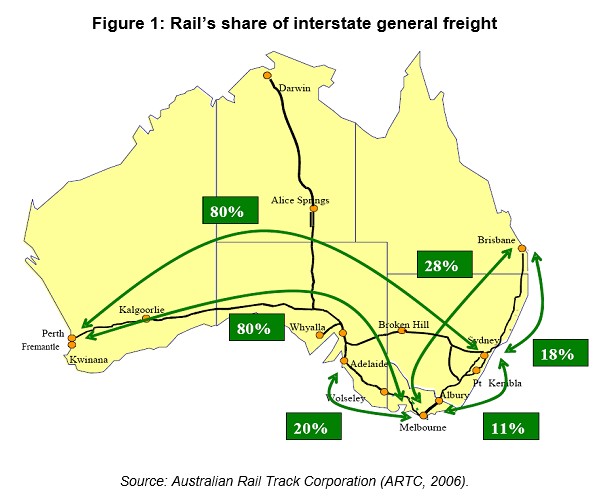While the media’s attention has focused on the proposal to build a high speed passenger rail line linking the East Coast capitals, several commentators have instead thrown support behind an inland rail freight line linking Melbourne and Brisbane.
Last week, former Nationals leader, John Anderson, called on the Federal Government to commit to funding a 1,700 kilometre inland rail freight line connecting Melbourne to Brisbane. Previous analysis released last year by Anderson suggested an inland railway would cost around $11 billion and would run through country towns like Moree, Narromine, Parkes, Wagga Wagga and Albury, thereby ensuring freight trains do not have to travel through the congested Sydney rail network.
Today, the federal member for Gippsland in regional Victoria and Minister for Infrastructure and Transport, Darren Chester, has penned a piece in The Australian arguing that an inland rail freight line could transform freight transport in less than a decade:
With a dedicated freight link down the east coast of Australia, providing a Melbourne to Brisbane transit time of less than 24 hours, inland rail will connect our regions to our ports, reduce congestion in our cities and create safer regional roads — and we can build it within a decade…
The demand for our goods and services continues to increase. Between 2016 and 2030, road freight is expected to grow by 40 per cent and in the same period non-containerised exports from major ports will grow 90 per cent.
Our present east-coast railway… is constrained by a 19th century alignment…
[The inland rail line] will travel through inland eastern Australia, completing the backbone of our national rail network by linking southeast Queensland more directly with Adelaide and Perth and connecting every major port in the nation.
It will deliver a sizeable shift in the productivity of eastern freight services that will benefit the nation as a whole for the next century…
Inland Rail has the capacity to remove about 200,000 truck movements each year off the east coast corridor. One train carries about the same as 110 B-double trucks. This will have flow on benefits to communities by reducing congestion on our roads and making our highways significantly safer.
The most recent cost estimate for the project is $10.7 billion, a figure that is more than balanced by the direct and indirect benefits to the nation of over $22 billion…
Infrastructure Australia has also listed Inland Rail as one of the 93 priority infrastructure projects in its 15 year Australian Infrastructure Plan…
As noted previously, building an inland rail freight network from Melbourne and Brisbane (including connections to Sydney) has a lot of merit, along with building world class intermodal connections at key locations along the way so transfers between rail and truck are fast and efficient.
Rail is particularly well suited to two types of freight:
- Bulk Freight: rail is suited to the provision of high volume bulk freight services to export facilities because it generally requires well defined point-to-point transport only (such as directly from silo/mine to port) with no requirement for trucking at any intermediate points. Rail can also transport larger volumes in shorter periods to meet shipping requirements and minimise on-port storage.
- Long-haul General (Containerised) Freight: Road has inherent competitive advantages in the transportation of short-haul general freight because of its ability to offer a flexible door to door service without modal transfer (i.e. transfer to/from rail) and its capacity to handle small shipment sizes. However, rail tends to be more price competitive over longer distances where pick-up-and-delivery costs are reduced in unit cost per kilometre terms.
However, despite the long distance between Melbourne and Brisbane, rail’s share of general freight was just 28% in 2006, whereas it was 80% between the East Coast and Perth (see below).

A key reason why rail’s share is so low is because it shares the track with the passenger rail network in Sydney, which has priority. This makes rail freight far slower and less reliable than road transport, despite what should be a strong natural advantage (i.e. the very long distance travelled).
The end result is that thousands of truck trips are taken between Melbourne and Brisbane when, given decent infrastructure, rail could easily be fulfilling the role instead.
Accordingly, road trauma is higher than would otherwise be the case, as are greenhouse gas emissions, given one long freight train could replace around 110 B-Double trucks. Farmers are also forced to endure higher costs in delivering their goods to port, thus reducing their competitiveness.
The $11 billion cost of building an inland rail freight line is also a tiny fraction of the $110 billion estimated cost of building a high speed passenger network, which has received much more political support despite dubious economic benefits.
In short, inland rail is the type of productivity enhancing “nation building” project that Australia needs.

